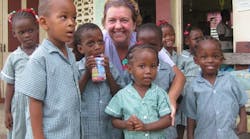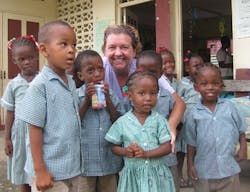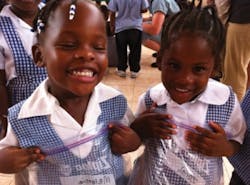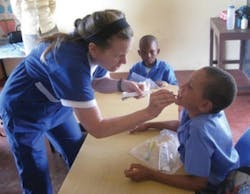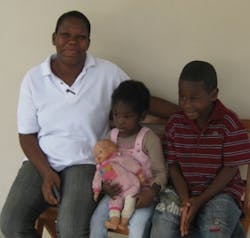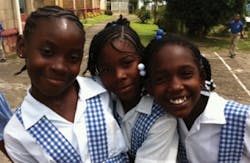Nearly 85% of children in Grenada suffer from untreated dental caries
by Cynthia J. Howard, RDH, MS, and Jill B. Fernandez, RDH, MPH
In January 2010, New York University College of Dentistry (NYUCD) began a two-week national oral health survey in Grenada. Grenada is located in the southeastern Caribbean Sea northwest of Trinidad and Tobago and northeast of Venezuela. It is known as the “Island of Spice” due to the production of nutmeg, cinnamon, cloves, ginger, and other crops for which Grenada is the world’s largest exporter. Its 133 square miles of land holds an estimated population of 110,000, 24% of which are schoolchildren.
Grenada is a three-island state made up of the main island of Grenada, Carriacou, and Petite Martinique. Grenada is the largest of the three islands, with most of the population residing there. The island is further divided into six parishes: St. George, St. John, St. Mark, St. Patrick, St. Andrew, and St. David. The capital city is St. George’s.
A total of 1,075 dental exams were performed on children between the ages of 6 and 15.The overall presence of caries was alarmingly high at approximately 84%. More than eight out of every 10 Grenadian children suffer from untreated dental caries. One-third of all children who participated in the survey were missing a permanent first molar due to caries, and the mean number of caries surfaces was 8.6 per child. This is some of the highest recorded incidence of dental caries in the world, according to WHO Global Oral Health Data Bank.
The first year’s cost of implementing this program is U.S. $100,000. The Ministry of Health has agreed to cover the cost of housing, meals, and transportation for the NYUCD team. Some of these costs may be shared with local NGOs and business owners, at the Ministry’s discretion. NYUCD will be providing the personnel, funding airfare, and bringing necessary dental supplies and equipment.
The goal of this outreach initiative was to create a sustainable oral health model for Grenada by working with the existing infrastructure, incorporating preventive measures nationwide, and providing needed treatment. This program will kick off a new school health initiative, which involves collaboration with the Ministry of Health and Ministry of Education. This massive undertaking required experienced oral health professionals, including dentists, dental hygienists, and dental students. In this article, Professors Cynthia Howard and Jill Fernandez from New York University College of Dentistry share their experiences in their two-week outreach program inCynthia J. Howard, RDH, MS
When I became an adjunct clinical faculty member at New York University College of Dentistry, Dental Hygiene Department in November of 2010, I never thought I would be given the opportunity to travel on a public health outreach. I received an email asking dental hygiene faculty if anyone was interested in participating in a two-week global outreach program to the island of Grenada in February 2011. Since my children are grown and I have extra time on my hands, it did not take long for me to decide to go on this adventure. After many years as a dental hygiene educator, I felt this was an opportunity of a lifetime and a service I could provide with my professional background. Since Grenada is located in the Caribbean, I could only dream what a working vacation this would be!
Weeks before the trip, I met the team of professionals I would work with for an orientation. The team consisted of dentists, dental students, dental hygienists, and administrative personnel. We received an overview of the island and our task for the two-week period. I learned that a team was sent previously to determine the needs of the children of Grenada. I was astonished by the fact that the caries rate among the children who were surveyed was 84%. On our trip the team was to provide a toothbrush, toothpaste, and a sealable plastic bag to each child. Our mission was to teach and demonstrate toothbrushing, apply fluoride varnish, and explain to the teachers how to use classroom oral health logs. Their task was to have the children brush their teeth every day and record the daily toothbrushing. My first job prior to the trip was to pack up cases of varnish and plastic bags in duffel bags — a total of 25 duffel bags. Needless to say, it was a long day.
I met the team on the morning of our departure as we were transported to the airport in a chartered bus. I was surprised to find out that another dental hygienist on the team graduated a year after me from the same dental hygiene school as I did. Although we did not know each other in school, we had a common bond and subsequently established an ongoing friendship. The flight was uneventful, the view upon descent was breathtaking, and the anticipation of the two weeks to follow was upon us.Once we arrived at our destination, we were ready to embark on our mission the next day. I did not realize that Grenada housed spectacular beaches, rolling mountains, rain forests, and plush greenery. We started the day by filling the van with supplies at base camp and began our journey to preschools, grammar schools, and high schools. I was amazed at the schoolchildren dressed in pristine uniforms walking to school on winding roads with their parents. When we arrived at each school we began the lesson, distributed toothbrushes, applied varnish, and explained the oral health logs to the teachers.
What struck me as I started was the willingness of the children to learn, the smiles on their faces, and the tenderness they demonstrated. They were so excited to see us that they asked, “Are you here to fix my teeth?” What I noticed was the rampant decay and the need for dental services. Sometimes we had to wait because it was during lunch when we arrived, and this is when I noticed the unhealthy snacks the children ate.
After we finished for the day, we went back to base camp, refilled the vans, and completed writing the oral health logs with the students’ names for the next day. What impressed me most was that the teamsI was surprised that another team arrived to perform clinical dental services for one week. I was present for two days to help out with the setup and the running of the clinic. I was amazed at the portable equipment that arrived from New York. When the clinical day began, patients were already waiting for dental services. The clinic was divided into four working rooms: operative, endodontic, pediatric, and oral surgery. Patients were triaged and sent to their designated treatment areas. Sometimes the wait was long, but I did not hear any complaints. The team was able to see 748 patients and administered 2,666 treatments. The patients were very grateful and asked when the clinic team would return. The clinical team is scheduled to make a return trip to Grenada next year for this outreach mission.
At the writing of this article, we were scheduled to return to Grenada in September 2011. It will be interesting to see if the children recognize us. I am looking forward to another two great weeks of hard work. Little did I realize that this commitment of two weeks would be one of the best rewards in my life! With all my heart I will be back to Grenada serving the dental health needs of the children.Jill B. Fernandez, RDH, MPH
Moments before landing at Maurice Bishop International Airport in Grenada, I looked out the window of the jumbo jet to see the cool blue waters of the Caribbean. As the island grew closer, I could make out the palm trees, miles and miles of sandy beaches, and I pictured myself sipping a margarita under a palm frond. Most of the people on the flight were beginning their vacation and would soon be frolicking in the surf, but for me and 19 others from New York University College of Dentistry, we were beginning an adventure that was like no other we’d ever experienced. How did I get so lucky?
Currently I am the director of the pediatric outreach and prevention program in the Department of Pediatric Dentistry at NYUCD. I have accompanied many teams at the college on outreach trips both internationally and locally, but I have never participated in such a broadscale oral health initiative to improve the oral health of a whole country.
As I walked down the stairs of the plane, the first thing that hit me was the heat. Leaving New York City in the winter was a welcome treat. Shuffling our way through immigration and customs, we were at last on our way to the hotel located on one of the most beautiful beaches in all of Grenada.
After checking into our hotel and getting a good night’s rest, we had our game plan for the next two weeks. Our team of 20 would be further divided among vehicles and even further divided into teams of three or four people. Each day, our vans would take us across the island to different schools, some as far as an hour away. Driving across the hilly, snaking roads was not for the faint of heart, but once we arrived at a school, we quickly went into action. Our smaller teams would begin by going into classrooms, distributing toothbrushes, toothpaste, and brushing logs to teachers. Children were taught how to brush and prevent tooth decay, followed up by a fluoride varnish. In addition, our team offered oral health education workshops for parents, teachers, nurses, and the island’s public health dental personnel. Parents were shocked to know the number of Grenadian children with dental caries. They were eager to have their children participate in the program and help improve oral health. On a good day, we saw a few thousand children; the only bad days were when we found ourselves all the way across the other side of the island at the end of the day and knew we had another long, crazy van ride back to the hotel.
Since our trip, follow-up visits to the island have continued to provide fluoride varnish and toothbrushing logs at each school. On our most recent trip, we incorporated a sealant program for the kindergarten through third grades. We will continue our visits until 2013, at which time we will conduct another oral health survey to evaluate our program. I am confident at that time that we will see a reduction in new caries. It is exciting to think that we might have improved the oral health of an entire country and that children might grow up to live healthier lives in part because of these efforts.
Professor Cynthia J. Howard is a clinical assistant professor at the New York University College of Dentistry Department of Dental Hygiene. Professor Jill B. Fernandez is a clinical associate professor and director of global pediatric outreach and prevention programs at the New York University College of Dentistry Department of Pediatric Dentistry.
Past RDH Issues
